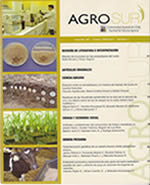Determination of the main variables that affect the primary and secondary productivity of sown pastures in a humid sub-tropical environment
Main Article Content
Abstract
The forage and meat production of sown pastures, a forage mixture of Festuca arundinacea, Lotus corniculatus and Trifolium repens, was evaluated for 4 years under three animal endowments (2, 4, 6 steers) to evaluate the forage and meat production of sown pastures. A DBCA was used with three blocks and the variables were analysed using Anava and classification and decision trees (CART) with the R statistical package. The results of the decision trees showed that regardless of age and animal load, the greatest plant and animal response was related to the season of the year. Spring presented the highest primary and secondary production, which can be explained by the initially high incident radiation, rainfall of 400 mm and temperatures up to 24 ºC. Under these conditions, the management variable that determined the highest forage production was the forage that disappeared, indicating that it is highly related to the photosynthetic quality of the remaining forage. During the rest of the seasons (summer, autumn, winter) the highest forage production was reached with available forage reaching 2000 kg/ha DM while the lowest was 700 kg/ha DM under extreme situations. Meat production showed similar behaviour to forage production, with spring being the season of highest productivity, with loads close to 1150 kg/ha of DM allowing production of around 485 kg/ha of DM. This behaviour reinforces the maintenance of high loads in the seasons of high forage production (spring) to maintain photosynthetic efficiency and pasture quality to achieve high meat yields per surface area and the need to finish the animals before summer.

